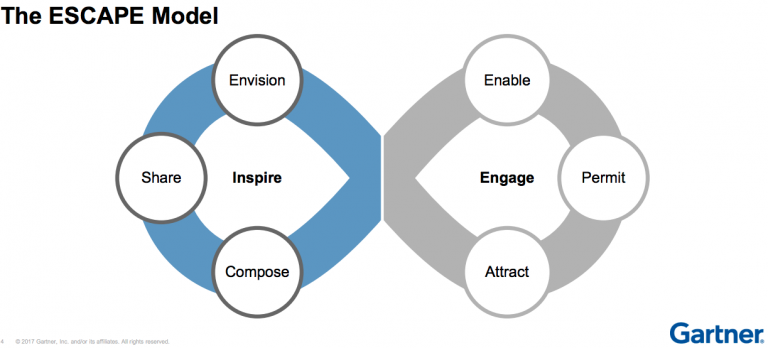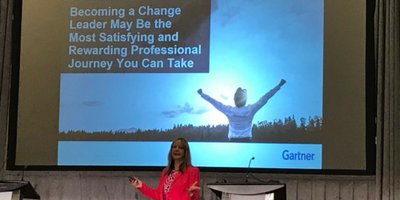By Brian Jackson, Editorial Director, IT World Canada
VANCOUVER – If you’re leading a change management initiative at your organization, you might feel like you just need to escape – and that’s exactly what Gartner research vice-president Elise Olding advocates, but not in the way you’d expect.
“If you want your organization to change, you and your leadership must change first,” she tells the packed room at the CIO Peer Forum on Tuesday. “I’m going to share with you a change superpower.”
That superpower is the ESCAPE model that Olding has developed at Gartner with the help of fellow Gartner Reseach VP Bard Papegaaij. When you wield this superpower, you have a sort of super adaptability to change. The ESCAPE model has two halves – the “inspire” half and the “engage” half. On the inspire side, we have Envision, Share, and Compose. On the engage side, we have Attract, Permit, and Enable. Put those six steps together and you get ESCAPE. Olding explained it in detail.

Inspire leadership, inspire change
It starts with inspiration to bring about an energized feeling, Olding said. Then it moves to soliciting engagement because that keeps the energy going and invites participation and strengthens teamwork. Overall, it helps departments look beyond their cubicle walls and think of the broader organization as one team.
A powerful force is required to translate reluctance into a desire for change. Start by helping others envision it.
“When I was eight years old, my Dad took me hiking up a waterfall,” Olding recalls. “It wasn’t a lot of fun then and my legs were killing me. But because my Dad was really excited about it and wanted to show me something really special, it gave me the wherewithal to accomplish something I really didn’t want to do.”
That’s what setting a vision is about. Executives that are afraid of failure when approaching a big moonshot project are doing it right, she says. Being uncomfortable keeps you on your toes and can help motive crafting a good story to help employees shape their vision.
But telling the story is only part of the battle. Sharing means tirelessly putting forward your vision, and equally listening to what employees have to say about it. Be present and keep in mind that employees aren’t going to absorb your message instantly, Olding says.
“You have to hear something seven times before you begin to understand it.”
To compose the moonshot, you better make sure your leadership team agrees on what they’re trying to accomplish. To see if they do, try an exercise of having everyone in your leadership team independently write down their top five leadership beliefs on a piece of paper. Compare them and if they don’t match, then you’re likely to wreak havoc with any big change project.
Also, be welcoming to employees that raise problems, she adds. Don’t just send them away to come up with their own solution. It’s important to try to anticipate what might be a barrier in the future.
Engage for change
Attract starts with early adopters. Try to identify them at your organization and then encourage interactive participation. Don’t just fall back on your usual “go-to” people but seek to interact with new people at your company often.
“Get rid of your high-potential lists,” Olding says. “When we make decisions about what people can accomplish, it’s a self-fulfilling prophecy.”
Also be patient for different styles of adopting change. Some may be slower than others, but if they’re making progress, that is what counts.
Next, permit your employees to have ideas. Avoid the trap of blaming people for failure.
“You have to convince your organization that if they try to do something and they fail, they’re not going to get whacked on the head,” she says.
Encourage people to behave in new ways, measuring their own growth instead of comparing to what others are achieving. Olding shares an example of one CIO she knows that at a managment meeting, asked each manager to share something that a member of their team accomplished. The other management was encouraged to talk to the employee about that.
“It broke down the silos. It created collaboration,” she says. “Even small things like this scale up to change in your organization.”
Don’t be surprised if you find the effort draining, she concludes. Change is hard and leaders must make sure they take the time needed to recharge.
Brian Jackson is Editorial Director of IT World Canada. He covers technology as it applies to business users. Multiple COPA award winner and now judge. Paddles a canoe as much as possible.
This article first appeared on IT World Canada as part of their coverage of the CIO Peer Forum 2018 in Vancouver. Check out https://www.itworldcanada.com/tag/CIO-Peer-Forum for Brian’s full reporting on the CIO Peer Forum 2018.
